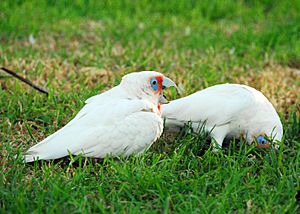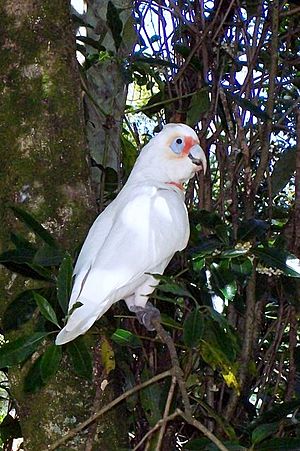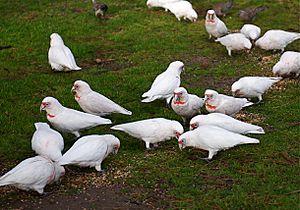Long-billed corella facts for kids
Quick facts for kids Long-billed corella |
|
|---|---|
 |
|
| Conservation status | |
| Scientific classification |
The long-billed corella (Cacatua tenuirostris) is a type of cockatoo that lives in Australia. It looks a lot like the little corella and the sulphur-crested cockatoo. This bird is mostly white. It has a reddish-pink face and forehead. Its long, pale beak helps it dig for roots and seeds. It also has reddish-pink feathers on its chest and belly.
Contents
About the Long-Billed Corella
The long-billed corella is a unique species. It means there are no different types or subspecies of this bird. A German scientist named Heinrich Kuhl first described it in writing in 1820. But the First Nations peoples of Australia knew about it long before that. This bird is part of a group of cockatoos called corellas. They are all known as "white cockatoos."
What They Look Like
Adult long-billed corellas are about 38 to 41 centimeters (15 to 16 inches) long. Their wings can spread out to about 80 to 90 centimeters (31 to 35 inches). They usually weigh around 567 grams (1.25 pounds). They have a long, bone-colored beak. Around their eyes, they have a rim of bluish skin with no feathers. Their body is mostly white. They have reddish feathers around their eyes and on their face. The feathers under their wings and tail have a hint of yellow.
Where They Live
You can find long-billed corellas in the wild in Victoria and southeastern New South Wales. In the last 20 years, they have spread to new areas. Now, you can also find them in Tasmania, Adelaide, and southeast Queensland. There is also a group of these birds living wild in Perth. This is important because they might mix with the endangered western corella.
Long-billed corellas like to live in grassy woodlands and grasslands. This includes places like pastures, farm fields, and city parks.
How They Live

Their Calls
The long-billed corella makes a quick, shaky, high-pitched sound. It can sound like currup!, wulluk-wulluk, or cadillac-cadillac. They also make harsh screeching noises.
Reproduction and Life Cycle
Long-billed corellas usually breed from July to November. They form pairs that stay together. Both the male and female birds help build the nest. They also take turns sitting on the eggs and caring for their young. Nests are often made in old, hollow trees. Sometimes, they nest in holes in rocky cliffs.
They lay 2 to 3 dull white, oval-shaped eggs. The eggs are laid on a bed of old wood. The eggs hatch after about 24 days. The young birds stay in the nest for about 56 days.
What They Eat
Long-billed corellas often dig for their food. They look for roots, seeds, and bulbs. They especially like a weed called onion grass. They also eat native plants like murnong. But now, a lot of their food comes from plants that were brought to Australia from other places. They also enjoy eating sunflower seeds.
Corellas and People
As Pets
Long-billed corellas are now popular pets in many parts of Australia. They used to be rare as pets, but their numbers have grown. People like them because they can copy words and even whole sentences very well. Many say the long-billed corella is the best "talker" among Australian cockatoos. Some even say they are the best talking parrots in Australia.
As Pests
Long-billed corellas are sometimes seen as pests, especially by farmers. They can cause a lot of damage to crops. They are also known for tearing up asphalt along roads. They can even damage power lines. In some areas, permits are given to control their numbers. In NSW, corellas are a common problem on sports fields and golf courses. They can dig holes up to 3 inches wide and 6 inches deep in the ground.
In July 2019, about 60 corellas in Adelaide, South Australia, died. They were found bleeding from their mouths and making sounds. It was thought they might have been poisoned. Most of the birds were long-billed corellas. People hoped that whoever poisoned them would be found. In Australia, people need to register if they buy poisons. The local council had previously suggested controlling corella numbers. This was because the birds were damaging crops, streetlights, and other buildings. They were also pushing out other native birds and animals.
See also
 In Spanish: Cacatúa picofina para niños
In Spanish: Cacatúa picofina para niños




